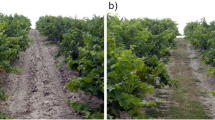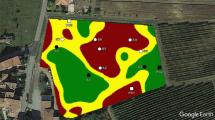Abstract
Knowledge of spatial variability of soil fertility and plant nutrition is critical for planning and implementing site-specific vineyard management. To better understand the key drivers behind vineyard variability, yield mapping from 2002 to 2005 and 2007 (the monitor broke down in 2006) was used to identify zones of different productive potential in a Pinot Noir field located in Raimat (Lleida, Spain). Simultaneously, the vineyard field was sampled in 2002, 2003 and 2007, applying three different schemes (depending on the number of target vines in different grape yield zones). The sampling carried out in 2002, which involved different soil, topographic and crop properties (mineral contents in petiole), made it possible to evaluate the influence of these parameters on the grape yield variability. The zones of lowest yield coincided with locations in which the nutritional status of the crop exhibited the lowest values, particularly with respect to petiole contents of calcium and manganese. Sampling systems adopted in 2003 and 2007 (grape quality and soil attributes) confirmed the inverse spatial correlation between grape yield and some grape quality parameters and, more importantly, showed that the percentage of soil carbonates had a great influence on grape quality probably due to the reduced availability of manganese in calcareous soils. Site-specific vineyard management could therefore be considered using two different strategies: variable-rate application of foliar fertilizers to increase the yield in areas with low production and also foliar or soil fertilizers to improve the quality specifications in some areas.







Similar content being viewed by others
References
Acevedo-Opazo, C., Tisseyre, B., Guillaume, S., & Ojeda, H. (2008). The potential of high spatial resolution information to define within-vineyard zones related to vine water status. Precision Agriculture, 9, 285–302.
Arnó, J., Bordes, X., Ribes-Dasi, M., Blanco, R., Rosell, J. R., & Esteve, J. (2005). Obtaining grape yield maps and analysis of within-field variability in Raimat (Spain). In: J. V. Stafford (Eds.) Precision Agriculture’05. Proceedings of the 5th European conference on precision agriculture (pp. 899–906). Wageningen, The Netherlands: Wageningen Academic Publishers.
Arno, J., Martínez-Casasnovas, J. A., Ribes-Dasi, M., & Rosell, J. R. (2011). Clustering of grape yield maps to delineate site-specific management zones. Spanish Journal of Agricultural Research, 9(3), 721–729.
Bramley, R. G. V. (2001). Variation in the yield and quality of winegrapes and the effect of soil property variation in two contrasting Australian vineyards. In: G. Grenier & S. Blackmore (Eds.), Proceedings of the 3rd European conference on precision agriculture (pp. 767–772). France: Agro Montpellier.
Bramley, R. G. V. (2005). Understanding variability in winegrape production systems. 2. Within vineyard variation in quality over several vintages. Australian Journal of Grape and Wine Research, 11, 33–42.
Bramley, R. G. V., & Hamilton, R. P. (2004). Understanding variability in winegrape production systems. 1. Within vineyard variation in yield over several vintages. Australian Journal of Grape and Wine Research, 10, 32–45.
Bramley, R. G. V., & Hamilton, R. P. (2007). Terroir and precision viticulture: are they compatible? Journal International des Sciences de la Vigne et du Vin, 41(1), 1–8.
Bramley, R.G.V., & Lamb, D.W. (2003). Making sense of vineyard variability in Australia. In R. Ortega & A. Esser (Eds.), Precision viticulture. Proceedings of the IX Congreso Latinoamericano de Viticultura y Enología (pp. 35–54). Santiago, Chile: Pontificia Universidad Católica.
Bramley, R. G. V., Ouzman, J., & Boss, P. K. (2011). Variation in vine vigour, grape yield and vineyard soils and topography as indicators of variation in the chemical composition of grapes, wine and wine sensory attributes. Australian Journal of Grape and Wine Research, 17, 217–229.
Bramley, R., & Proffitt, T. (1999). Managing variability in viticultural production. The Australian Grapegrower & Winemaker, 427, 11–16.
Bramley, R. G. V. & Williams, S. K. (2001). A protocol for winegrape yield maps. In G. Grenier & S. Blackmore (Eds.) Proceedings of the 3rd European conference on precision agriculture (pp 773–778). France: Agro Montpellier.
Hall, A., Lamb, D. W., Holzapfel, B. P., & Louis, J. P. (2010). Within-season temporal variation in correlations between vineyard canopy and winegrape composition and yield. Precision Agriculture, 12, 103–117. doi:10.1007/s11119-010-9159-4.
Hidalgo, J. (2006). La calidad del vino desde el viñedo (The quality of wine from the vineyard). Madrid, Spain: Mundi-Prensa.
Hosmer, D. W., & Lemeshow, S. (1989). Applied logistic regression. New York: Wiley.
Iland, P., Bruer, N., Edwards, G., Weeks, S., & Wilkes, E. (2004). Chemical analysis of grapes and wine: techniques and concepts. Campbelltown, South Australia: Patrick Iland Wine Promotions.
Mallarino, A. P., Oyarzabal, E. S., & Hinz, P. N. (1999). Interpreting within-field relationships between crop yields and soil and plant variables using factor analysis. Precision Agriculture, 1, 15–25.
Manly, B. F. J. (1994). Multivariate statistical methods. A primer. London, England: Chapman & Hall.
Martínez-Casasnovas, J. A., & Bordes, X. (2005). Viticultura de precisión: Predicción de cosecha a partir de variables del cultivo e índices de vegetación (Precision Viticulture. Predicting grape yield from crop variables and vegetation indices). Revista de Teledetección, 24, 67–71.
Minasny, B., McBratney, A. B., & Whelan, B. M. (2005). VESPER version 1.62. Australian Centre for Precision Agriculture. http://www.usyd.edu.au/su/agric/acpa. Accessed 1 Dec 2011.
Ortega, R. A., Esser, A., & Santibáñez, O. (2003). Spatial variability of wine grape yield and quality in Chilean vineyards: economic and environmental impacts. In J. Stafford, A. Werner (Eds.), Precision agriculture. Proceedings of the 4th European conference on precision agriculture (pp. 499–506). Wageningen, The Netherlands: Wageningen Academic Publishers.
Santesteban, L. G., Miranda, C., Jiménez, C., Fuentemilla, M., Urretavizcaya, I., Tisseyre, B., et al. (2010). Evaluation of the interest of NDVI to identify distinct management units in vineyards. Revista de Teledetección, 33, 11–16. [In Spanish].
Tardaguila, J., Baluja, J., Arpon, L., Balda, P., & Oliveira, M. (2011). Variations of soil properties affect the vegetative growth and yield components of “Tempranillo” grapevines. Precision Agriculture, 12, 762–773.
Taylor, J.A. (2004). Digital terroirs and precision viticulture: Investigations into the application of information technology in Australian vineyards. PhD Thesis, The University of Sydney, Australia.
Tisseyre, B., Mazzoni, C., Ardoin, N., & Clipet, C. (2001). Yield and harvest quality measurement in precision viticulture—Application for a selective vintage. In: G. Grenier & S. Blackmore (Eds.), Proceedings of the 3rd European conference on precision agriculture (pp. 133–138). France: Agro Montpellier.
Tisseyre, B., Mazzoni, C., & Fonta, H. (2008). Within-field temporal stability of some parameters in viticulture: Potential toward a site specific management. International Journal of Wine and Vine Research, 42, 27–39.
Tisseyre, B., Taylor, J., & Ojeda, H. (2007). New technologies and methodologies for site-specific viticulture. International Journal of Wine and Vine Research, 41, 63–76.
Acknowledgments
The authors would like to thank the Codorníu Group for the trust and confidence that it has placed in this research and for providing the authors with the opportunity to carry out this work through a collaboration programme.
Author information
Authors and Affiliations
Corresponding author
Rights and permissions
About this article
Cite this article
Arnó, J., Rosell, J.R., Blanco, R. et al. Spatial variability in grape yield and quality influenced by soil and crop nutrition characteristics. Precision Agric 13, 393–410 (2012). https://doi.org/10.1007/s11119-011-9254-1
Published:
Issue Date:
DOI: https://doi.org/10.1007/s11119-011-9254-1




